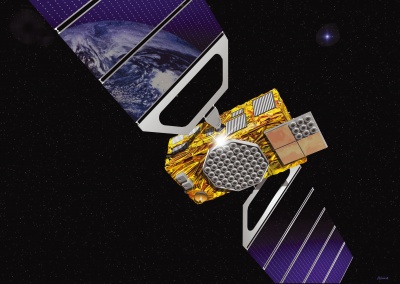If you wish to contribute or participate in the discussions about articles you are invited to contact the Editor
Galileo: Difference between revisions
mNo edit summary |
mNo edit summary |
||
| Line 6: | Line 6: | ||
|YearOfPublication=2000 | |YearOfPublication=2000 | ||
}} | }} | ||
==Introduction== | |||
The Galileo Space Segment will comprise a constellation of a total of 30 Medium Earth Orbit (MEO) satellites, of which 3 are spares, in a so-called Walker 27/3/1 constellation. | |||
Each satellite will broadcast precise time signals, ephemeris and other data. The Galileo satellite constellation has been optimised to the following nominal constellation specifications: | |||
* circular orbits (satellite altitude of 23 222 km) | |||
* orbital inclination of 56° | |||
* three equally spaced orbital planes | |||
* nine operational satellites, equally spaced in each plane | |||
* one spare satellite (also transmitting) in each plane | |||
The Galileo satellite is a 700 kg/1600 W class satellite. | |||
[[File:Galileo satellite system.jpg|none|thumb|400px|alt=Galileo satellite system|Galileo satellite system]] | |||
Galileo | |||
The image shows an artist's impression of a Galileo spacecraft in orbit with solar arrays deployed. The spacecraft rotates about its Earth-pointing axis so that the flat surface of the solar arrays always faces the Sun to collect maximum solar energy. The antennas, shown on the underside of the body in the picture, always point towards the Earth. The spacecraft body will measure 2.7 m x 1.1 m x 1.2 m and the deployed solar arrays span 13 m. | |||
[[Category:GALILEO]] | [[Category:GALILEO]] | ||
Revision as of 12:48, 20 February 2011
| GALILEO | |
|---|---|
| Title | Galileo |
| Author(s) | Name. |
| Level | Basic |
| Year of Publication | 2000 |
Introduction
The Galileo Space Segment will comprise a constellation of a total of 30 Medium Earth Orbit (MEO) satellites, of which 3 are spares, in a so-called Walker 27/3/1 constellation.
Each satellite will broadcast precise time signals, ephemeris and other data. The Galileo satellite constellation has been optimised to the following nominal constellation specifications:
* circular orbits (satellite altitude of 23 222 km) * orbital inclination of 56° * three equally spaced orbital planes * nine operational satellites, equally spaced in each plane * one spare satellite (also transmitting) in each plane
The Galileo satellite is a 700 kg/1600 W class satellite.
Galileo The image shows an artist's impression of a Galileo spacecraft in orbit with solar arrays deployed. The spacecraft rotates about its Earth-pointing axis so that the flat surface of the solar arrays always faces the Sun to collect maximum solar energy. The antennas, shown on the underside of the body in the picture, always point towards the Earth. The spacecraft body will measure 2.7 m x 1.1 m x 1.2 m and the deployed solar arrays span 13 m.

